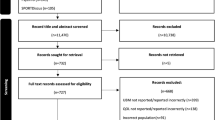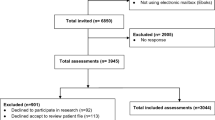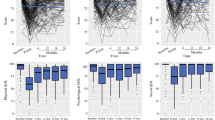Abstract
The aim of this systematic review was to identify the prevalence and severity of upper limb problems following surgery and radiation for early breast cancer. Additionally, the independent prognostic contribution of radiation, type of breast surgery, type of axillary surgery, age and body mass index (BMI) was evaluated. Searches of electronic databases were conducted to identify articles that reported upper limb and quality of life outcomes after breast cancer surgery and external radiation. Eligible studies for prognosis were longitudinal in design, with ≥95% of patients treated by surgery and radiation that excluded the axilla. Cross-sectional studies were also included for identification of prognostic factors. Where possible, the contribution of independent prognostic factors was analyzed. The review identified 32 relevant studies. Shoulder restriction was reported in between <1% and 67% of participants, lymphedema was reported in between 0 and 34% of participants, shoulder/arm pain was reported in between 9 and 68% of participants and arm weakness was reported in between 9 and 28% of participants. Quality of life was high across studies. Irradiated patients had slightly increased odds of lymphedema (OR = 1.46, 95% CI 1.16–1.84) and shoulder restriction (OR = 1.67, 95% CI 0.98–2.86) compared with non-irradiated patients. For patients undergoing surgery and radiation for breast cancer, the prognosis is good in terms of the upper limb and quality of life. Radiation that excludes the axilla does not appear to be a strong prognostic indicator of adverse upper limb outcomes.







Similar content being viewed by others
References
Centers for disease control and prevention (2004) Cancer survivorship – United States, 1971–2001. Morbidity and Mortality Weekly Report 53:526–529
Collins LG, Nash R, Round T et al (2004) Perceptions of upper-body problems during recovery from breast cancer treatment. Support Care Cancer 12:106–113
McCredie MRE, Dite GS, Porter L et al (2001) Prevalence of self-reported arm morbidity following treatment for breast cancer in the Australian Breast Cancer Family Study. Breast 10:515–522
Warner NJ, Rangan AM, Langlands AO et al (1998) Effect of concurrent chemotherapy and radiotherapy on breast cosmesis: a study of patients’ perceptions. Breast 7:131–136
Sugden EM, Rezvani M, Harrison JM et al (1998) Shoulder movement after the treatment of early stage breast cancer. Clin Oncol (R Coll Radiol) 10:173–181
The Steering Committee on Clinical Practice Guidelines for the Care and Treatment of Breast Cancer (1998) Mastectomy or lumpectomy? The choice of operation for clinical Stages I and II breast cancer. CMAJ 158(Suppl 3):S15–S21
Kissin MW, Querci della Rovere G, Easton D et al (1986) Risk of lymphoedema following the treatment of breast cancer. Br J Surg 73:580–584
Kwan W, Jackson J, Weir LM et al (2002) Chronic arm morbidity after curative breast cancer treatment: prevalence and impact on quality of life. J Clin Oncol 20:4242–4248
Nagel PH, Bruggink ED, Wobbes T et al (2003) Arm morbidity after complete axillary lymph node dissection for breast cancer. Acta Chir Belg 103:212–216
Chetty U, Jack W, Prescott RJ et al (2000) Management of the axilla in operable breast cancer treated by breast conservation: a randomized clinical trial. Br J Surg 87:163–169
Delouche G, Bachelot F, Premont M et al (1987) Conservation treatment of early breast cancer: long term results and complications. Int J Radiat Oncol Biol Phys 13:29–34
Johansson K, Ingvar C, Albertsson M et al (2001) Arm lymphoedema, shoulder mobility and muscle strength after breast cancer treatment – a prospective 2-year study. Adv Physioth 3:55–66
Schrenk P, Rieger R, Shamiyeh A et al (2000) Morbidity following sentinel lymph node biopsy versus axillary lymph node dissection for patients with breast carcinoma. Cancer 88:608–614
Giuliano AE, Haigh PI, Brennan MB et al (2000) Prospective observational study of sentinel lymphadenectomy without further axillary dissection in patients with sentinel node-negative breast cancer. J Clin Oncol 18:2553–2559
Mansel RE, Fallowfield L, Kissin M et al (2006) Randomized multicenter trial of sentinel node biopsy versus standard axillary treatment in operable breast cancer: the ALMANAC Trial. J Natl Cancer Inst 98:599–609
Ward S, Heidrich S, Wolberg W (1989) Factors women take into account when deciding upon type of surgery for breast cancer. Cancer Nurs 12:344–351
Pengel LHM, Herbert RD, Maher CG et al (2003) Acute low back pain: systematic review of its prognosis. BMJ 327:323
de Noronha M, Refshauge KM, Herbert RD et al (2006) Do voluntary strength, proprioception, range of motion, or postural sway predict occurrence of lateral ankle sprain? BJSM 40:824–828
Muaidi Q, Nicholson L, Refshauge K et al (in press) Prognosis of conservatively managed anterior cruciate ligament injury: a systematic review. Sports Medicine
Schulz KF, Chalmers I, Hayes RJ et al (1995) Empirical evidence of bias. Dimensions of methodological quality associated with estimates of treatment effects in controlled trials. JAMA 273:408–412
Emerson JD, Burdick E, Hoaglin DC et al (1990) An empirical study of the possible relation of treatment differences to quality scores in controlled randomized clinical trials. Control Clin Trials 11:339–352
Delgado-Rodriguez M, Sillero Arenas M (1995) Inclusion of research quality in meta-analyses. Gac Sanit 9:265–272
Ernst MF, Voogd AC, Balder W et al (2002) Early and late morbidity associated with axillary levels I-III dissection in breast cancer. J Surg Oncol 79:151–155
Tengrup I, Tennvall-Nittby L, Christiansson I et al (2000) Arm morbidity after breast-conserving therapy for breast cancer. Acta Oncol 39:393–397
Voogd AC, Ververs JM, Vingerhoets AJ et al (2003) Lymphoedema and reduced shoulder function as indicators of quality of life after axillary lymph node dissection for invasive breast cancer. Br J Surg 90:76–81
Parvanova V, Pandova V (1999) Radiotherapy without boost to the tumor bed after conservative surgery in the treatment of early breast cancer. J BUON 4:179–184
Barranger E, Dubernard G, Fleurence J et al (2005) Subjective morbidity and quality of life after sentinel node biopsy and axillary lymph node dissection for breast cancer. J Surg Oncol 92:17–22
Knobf MT, Sun Y (2005) A longitudinal study of symptoms and self-care activities in women treated with primary radiotherapy for breast cancer. Cancer Nurs 28:210–218
Lee TS, Kilbreath SL, Refshauge KM et al (2007) Pectoral stretching program for women undergoing radiotherapy for breast cancer. Breast Cancer Res Treat 102:313–321
Peintinger F, Reitsamer R, Stranzl H et al (2003) Comparison of quality of life and arm complaints after axillary lymph node dissection vs sentinel lymph node biopsy in breast cancer patients. Br J Cancer 89:648–652
Fehlauer F, Tribius S, Holler U et al (2003) Long-term radiation sequelae after breast-conserving therapy in women with early-stage breast cancer: an observational study using the LENT-SOMA scoring system. Int J Radiat Oncol Biol Phys 55:651–658
Ishiyama H, Niino K, Hosoya T et al (2006) Results of a questionnaire survey for symptom of late complications caused by radiotherapy in breast conserving therapy. Breast Cancer 13:197–201
Kiel KD, Rademacker AW (1996) Early-stage breast cancer: arm edema after wide excision and breast irradiation. Radiology 198:279–283
Sarin R, Dinshaw KA, Shrivastava SK et al (1993) Therapeutic factors influencing the cosmetic outcome and late complications in the conservative management of early breast cancer. Int J Radiat Oncol Biol Phys 27:285–292
Borger JH, Keijser AH (1987) Conservative breast cancer treatment: analysis of cosmetic results and the role of concomitant adjuvant chemotherapy. Int J Radiat Oncol Biol Phys 13:1173–1177
Yap KP, McCready DR, Narod S et al (2003) Factors influencing arm and axillary symptoms after treatment for node negative breast carcinoma. Cancer 97:1369–1375
Meric F, Buchholz TA, Mirza NQ et al (2002) Long-term complications associated with breast-conservation surgery and radiotherapy. Ann Surg Oncol 9:543–549
Tasmuth T, von Smitten K, Hietanen P et al (1995) Pain and other symptoms after different treatment modalities of breast cancer. Ann Oncol 6:453–459
Amichetti M, Busana L, Caffo O (1995) Long-term cosmetic outcome and toxicity in patients treated with quadrantectomy and radiation therapy for early-stage breast cancer. Oncology 52:177–181
Toledano A, Garaud P, Serin D et al (2006) Concurrent administration of adjuvant chemotherapy and radiotherapy after breast-conserving surgery enhances late toxicities: Long-term results of the ARCOSEIN multicenter randomized study. Int J Radiat Oncol Biol Phys 65:324–332
Herd-Smith A, Russo A, Muraca MG et al (2001) Prognostic factors for lymphedema after primary treatment of breast carcinoma. Cancer 92:1783–1787
Schulze T, Mucke J, Markwardt J et al (2006) Long-term morbidity of patients with early breast cancer after sentinel lymph node biopsy compared to axillary lymph node dissection. J Surg Oncol 93:109–119
Clark B, Sitzia J, Harlow W (2005) Incidence and risk of arm oedema following treatment for breast cancer: a three-year follow-up study. QJM 98:343–348
Amichetti M, Caffo O (2003) Pain after quadrantectomy and radiotherapy for early-stage breast cancer: incidence, characteristics and influence on quality of life. Results from a retrospective study. Oncology 65:23–28
Whelan TJ, Levine M, Julian J et al (2000) The effects of radiation therapy on quality of life of women with breast carcinoma: results of a randomized trial. Ontario Clinical Oncology Group. Cancer 88:2260–2266
Rayan G, Dawson LA, Bezjak A et al (2003) Prospective comparison of breast pain in patients participating in a randomized trial of breast-conserving surgery and tamoxifen with or without radiotherapy. Int J Radiat Oncol Biol Phys 55:154–161
Back M, Ahern V, Delaney G et al (2005) Absence of adverse early quality of life outcomes of radiation therapy in breast conservation therapy for early breast cancer. Australas Radiol 49:39–43
Schou I, Ekeberg O, Sandvik L et al (2005) Multiple predictors of health-related quality of life in early stage breast cancer. Data from a year follow-up study compared with the general population. Qual Life Res 14:1813–1823
Liljegren G, Holmberg L (1997) Arm morbidity after sector resection and axillary dissection with or without postoperative radiotherapy in breast cancer stage I. Results from a randomised trial. Uppsala-Orebro Breast Cancer Study Group. Eur J Cancer 33:193–199
Box RC, Reul-Hirche HM, Bullock-Saxton JE et al (2002) Physiotherapy after breast cancer surgery: results of a randomised controlled study to minimise lymphoedema. Breast Cancer Res Treat 75:51–64
Engel J, Kerr J, Schlesinger-Raab A et al (2003) Axilla surgery severely affects quality of life: results of a 5-year prospective study in breast cancer patients. Breast Cancer Res Treat 80:47–57
Lauridsen MC, Torsleff KR, Husted H et al (2000) Physiotherapy treatment of late symptoms following surgical treatment of breast cancer. Breast 9:45–51
Burak WE, Hollenbeck ST, Zervos EE et al (2002) Sentinel lymph node biopsy results in less postoperative morbidity compared with axillary lymph node dissection for breast cancer. Am J Surg 183:23–27
Schwarz R, Hinz A (2001) Reference data for the quality of life questionnaire EORTC QLQ-C30 in the general German population. Eur J Cancer 37:1345–1351
Cella D, Hahn EA, Dineen K (2002) Meaningful change in cancer-specific quality of life scores: differences between improvement and worsening. Qual Life Res 11:207–221
Maguire P (1999) Late adverse psychological sequelae of breast cancer and its treatment. Eur J Surg Oncol 25:317–320
Hayes S, Cornish B, Newman B (2005) Comparison of methods to diagnose lymphoedema among breast cancer survivors: 6-month follow-up. Breast Cancer Res Treat 89:221–226
Acknowledgement
TSL is a scholarship holder funded by the University of Sydney Postgraduate Award.
Author information
Authors and Affiliations
Corresponding author
Appendix 1
Appendix 1
Search Strategy
-
1.
epidemiological studies/
-
2.
randomized controlled trials/
-
3.
clinical trials/
-
4.
exp evaluation studies/
-
5.
exp case control studies/
-
6.
exp cohort studies/
-
7.
exp prospective studies/
-
8.
exp “outcome assessment (health care)”/
-
9.
exp prognosis/
-
10.
exp follow-up/
-
11.
longitudinal.mp
-
12.
retrospective.mp
-
13.
observational.mp
-
14.
prognos$.mp
-
15.
clinical course.mp
-
16.
predict$.mp
-
17.
outcome$.mp
-
18.
control$.mp
-
19.
random$.mp
-
20.
cohort$.mp
-
21.
or 1–20/
-
22.
animal/ not human/
-
23.
recurr$.mp
-
24.
22 not 23
-
25.
21 not 24
-
26.
exp breast cancer/
-
27.
(breast neoplasm or breast tumour or ductal carcinoma).mp
-
28.
26 or 27
-
29.
female not male
-
30.
28 and 29
-
31.
shoulder$.mp
-
32.
glenohumer$.mp
-
33.
humer$.mp
-
34.
pector$.mp
-
35.
(chest wall or upper limb or arm).mp
-
36.
exp radiation/
-
37.
(Xray or Radiation Therapy or Radiation Treatment or electron boost).mp
-
38.
exp surgery/
-
39.
(wide local excision or lumpectomy or mastectomy).mp
-
40.
or/31–39
-
41.
patient report$.mp
-
42.
quality of life.mp
-
43.
function$.mp
-
44.
disability$.mp
-
45.
range of motion.mp
-
46.
movement$.mp
-
47.
degree$.mp
-
48.
stiff$.mp
-
49.
tight$.mp
-
50.
strength$.mp
-
51.
weak$.mp
-
52.
force$.mp
-
53.
power$.mp
-
54.
circumference$.mp
-
55.
(lymphoedema or lymphedema or swelling).mp
-
56.
pain$.mp
-
57.
discomfort.mp
-
58.
or/41–57
-
59.
25 and 30 and 40 and 58
Rights and permissions
About this article
Cite this article
Lee, T.S., Kilbreath, S.L., Refshauge, K.M. et al. Prognosis of the upper limb following surgery and radiation for breast cancer. Breast Cancer Res Treat 110, 19–37 (2008). https://doi.org/10.1007/s10549-007-9710-9
Received:
Accepted:
Published:
Issue Date:
DOI: https://doi.org/10.1007/s10549-007-9710-9




